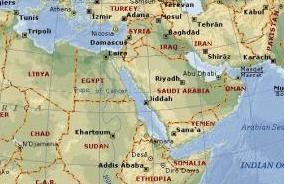-
posted by Anindya Sep 14th, 2011
 The unfolding developments on the streets of the Arab world are widely perceived as a struggle for democracy.
The unfolding developments on the streets of the Arab world are widely perceived as a struggle for democracy.However, once we place the uprisings in the context of other developments in the Middle East, it becomes clear that the Arab Spring is much more complex than that. More importantly, it shows that the risks posed to the global system and Southeast Asia are higher than many think.
First, the Arab Spring is still a work in progress, and the outlook is for yet more turbulence. Tunisia and Egypt have seen off their former authoritarian rulers, but are still in the process of working out new constitutional arrangements and elections. In Libya, while it is clear that the Qaddafi era is over, the civil war is not quite over. In Syria, the violent oppression of street protests continues. Any major upheaval in Syria would have potentially destabilizing implications for Lebanon and Israel.
In the Persian Gulf, Yemen’s ruler appears to have been eased out, but the country is at risk of becoming a failed state. In Bahrain, only forceful intervention by Saudi Arabia ended protests by the majority Shias against their Sunni rulers, but resentments are still simmering.
Second, it is important to appreciate that the political dynamic in the Middle East is changing independently of the uprisings in the Arab world and this is also increasing the risks in the region. The power balance in the Middle East is in a state of flux. There is a growing struggle for influence in the region between regional powers who are flexing their muscles. After many decades of disengagement, Turkey is now adopting a leadership role in the Middle East and making a play for support in the Arab world. Iran, too, is working hard to raise its profile. With a government in Iraq that is friendly to Iran and with strong links to powerful armed groups such as Hezbollah in Lebanon and Hamas in Gaza, it is challenging Saudi and American influence in the Arab world. Tensions along the Israel-Gaza-Egypt front are also rising.
Thus, the domestic uprisings could interplay with the wider struggles for influence in the Middle East to create a combustible mixture, which has a significant bearing for the rest of the world. Clearly, we are likely to see a lot more tensions and conflicts in the Middle East before the Arab Spring is done. Political risks will remain high in a region that is a critical supplier of oil to the rest of the world. Even where actual oil production is not at risk, the transportation of oil — through critical channels such as the Persian Gulf and the Suez Canal — could be at risk.
This has several implications for Southeast Asia.
Improving stability in Libya could allow 1.5 million barrels a day of oil back into oil markets and so keep oil prices down. However, if political risks elsewhere worsen as highlighted above, the risk premium in oil prices could rise and that could help keep oil prices uncomfortably high.
In other words, those who are currently arguing that a fall in oil prices will help support global economic growth in the face of severe problems in the United States and euro zone may be too optimistic. For us in Southeast Asia, high oil prices would keep consumer prices high and increase fiscal pressures in those countries which still retain fuel and other energy subsidies.
Continued instability in the Middle East will also make investors nervous, reducing risk appetites and so hurting valuations of asset markets in emerging economies such as Indonesia. Lower valuations are akin to a higher cost of capital and this could restrain capital spending. Virtually all Asean countries (except Brunei and Burma) now have capital markets and banking sectors that are open to foreign investors and lenders, so global risk appetites do impact capital flows and currencies.
Finally, the success of uprisings in the Middle East in precipitating regime change could embolden dissenting voices in other parts of Asia. In particular, the exposure of high-level corruption and cronyism in Arab dictatorships awakens Asians to rise against similar challenges in the region. Even in a country such as China, where political repression has long contained protests, the authorities are finding it harder to limit public backlashes against corruption or abuses of power. That is why China is already so concerned about the Arab Spring that it has stepped up repression of political dissent. India has seen a tidal wave of public revulsion against corruption, which has forced the government into a humiliating retreat on the issue of anti-corruption legislation. The Arab Spring could galvanize movements for reform in Southeast Asia, especially in countries where the public’s threshold of tolerance for corruption is already strained.
Of course, most Southeast Asian nations have made significant efforts in recent years to promote political reforms, improve social inclusiveness, set up corruption-fighting agencies and combat the power of vested interests, and are therefore in much better political shape than trouble spots such as in the Middle East. But it was precisely in Tunisia and Egypt where some reforms were undertaken that protests turned into revolutions.
The key lesson of the Arab Spring for us in Southeast Asia is that reform efforts must not lose momentum. Otherwise, we could see some turbulence in this part of the world.
Anindya Novyan Bakrie is vice chairman of the Indonesian Chamber of Commerce and Industry, CEO of Bakrie Telecom and chairman of VIVA Media Group.
Article in Jakarta Globe, September 13, 2011
http://www.thejakartaglobe.com/opinion/the-arab-spring-in-southeast-asia/465003
Leave a Reply
INSTAGRAM
TWITTER
FACEBOOK
-









